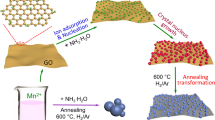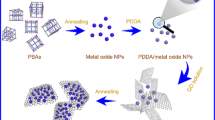Abstract
Manganous oxide (MnO)-based composites have motivated extensive researches as an anode electrode for lithium-ion storage due to the high theoretical capacity. Whereas, low cycling stability is the pivotal problem that retards the application of materials. Herein, a hydrothermal-annealing strategy is exploited to obtain the composite materials. The MnO nanoparticles (5–20 nm) wrapped by carbon shells to form core-shell structure are supported on the surface of reduced graphene oxide (rGO) sheets. The rGO flakes in electrode materials possess higher electrical conductivity, and improve the electro-conductibility and structural stability during charging-discharging process. Used as anode for lithium-ion batteries, the composite exhibits large reversible specific capacity (866 mA h g−1 at 0.2 C after 230 cycles) as well as a good cyclicity with a coulombic efficiency of 96%. The hydrothermal-annealing synthetic pathway opens up possibilities for designing and preparing novel electrode materials of lithium or other metallic ion batteries.

Manganous oxide (MnO)-based composites have motivated extensive researches as an anode electrode for lithium-ion storage due to the high theoretical capacity. Whereas, low cycling stability is the pivotal problem that retards the application of materials. Herein, a hydrothermal-annealing strategy is exploited to obtain the composite materials. The MnO nanoparticles (5–20 nm) wrapped by carbon shells to form core-shell structure are supported on the surface of reduced graphene oxide (rGO) sheets. The rGO flakes in electrode materials possess higher electrical conductivity, and improve the electro-conductibility and structural stability during charging-discharging process. Used as anode for lithium-ion batteries, the composite exhibits large reversible specific capacity (866 mA h g−1 at 0.2 C after 230 cycles) as well as a good cyclicity with a coulombic efficiency of 96%. The hydrothermal-annealing synthetic pathway opens up possibilities for designing and preparing novel electrode materials of lithium or other metallic ion batteries.





Similar content being viewed by others
References
Abouali S, Garakani MA, Kim JK (2018) Ultrafine SnO2 nanoparticles encapsulated in ordered mesoporous carbon framework for Li-ion battery anodes. Electrochim Acta 284:436–443. https://doi.org/10.1016/j.electacta.2018.07.162
Deng TS, Zhou XP (2016) The preparation of porous graphite and its application in lithium ion batteries as anode material. J Solid State Electrochem 20:2613–2618. https://doi.org/10.1007/s10008-016-3260-1
Deng XY, Zhu S, He F, Liu EZ, He CN, Shi CS, Li QY, Li JJ, Ma LY, Zhao NQ (2018) Three-dimensionally hierarchical Co3O4/carbon composites with high pseudocapacitance contribution for enhancing lithium storage. Electrochim Acta 283:1269–1276. https://doi.org/10.1016/j.electacta.2018.07.061
Diao JX, Wang G, Ma SH, Liu XJ (2018) Single-crystalline α-Fe2O3 nanohexahedron as outstanding anode material for lithium-ion batteries. J Nanopart Res 20(171). https://doi.org/10.1007/s11051-018-4207-5
Fan YF, Clavel G, Pinna N (2018) Effect of passivating Al2O3 thin films on MnO2/carbon nanotube composite lithium-ion battery anodes. J Nanopart Res 20(216). https://doi.org/10.1007/s11051-018-4315-2
Gnedenkov SV, Sinebryukhov SL, Zheleznov VV, Opra DP, Voit EI, Modin EB, Sokolov AA, Yu Ustinov A, Sergienko VI (2018) Effect of Hf-doping on electrochemical performance of anatase TiO2 as an anode material for lithium storage. R Soc Open Sci 5:171811. https://doi.org/10.1098/rsos.171811
Goodenough JB, Park KS (2013) The Li-ion rechargeable battery: a perspective. J Am Chem Soc 135:1167–1176. https://doi.org/10.1021/ja3091438
Gulbakan B, Yasun E, Shukoor MI, Zhu Z, You MX, Tan XH, Sanchez H, Powell DH, Dai HJ, Tan WH (2010) A dual platform for selective analyte enrichment and ionization in mass spectrometry using aptamer-conjugated graphene oxide. J Am Chem Soc 132:17408−17410. https://doi.org/10.1021/ja109042w
Han CG, Zhu CY, Aoki Y, Habazaki H, Akiyama T (2017) MnO/N–C anode materials for lithium-ion batteries prepared by cotton-templated combustion synthesis. Green Energy Environ 2:377–386. https://doi.org/10.1016/j.gee.2017.08.004
Hu AP, Cao W, Liu DN, Tang QL, Deng WN, Chen XH (2018) Saqima-like Co3O4/CNTs secondary microstructures with ultrahigh initial Coulombic efficiency as an anode for lithium ion batteries. J Solid State Electrochem 22:417–427. https://doi.org/10.1007/s10008-017-3759-0
Kaskhedikar BNA, Maier J (2009) Lithium storage in carbon nanostructures. Adv Mater 21:2664–2680. https://doi.org/10.1002/adma.200901079
Kim C, Jung JW, Yoon KR, Youn DY, Park S, Kim ID (2016) A high-capacity and long-cycle-life lithium-ion battery anode architecture: silver nanoparticle-decorated SnO2/NiO nanotubes. ACS Nano 10:11317−11326. https://doi.org/10.1021/acsnano.6b06512
Li MG, Lei WJ, Yu YS, Yang WW, Li J, Chen DF, Xu SC, Feng M, Li HB (2018) High-performance asymmetric supercapacitors based on monodisperse MnO nanocrystals with high energy densities. Nanoscale 10:15926−15931. https://doi.org/10.1039/C8NR04541K
Li QY, Yang Q, Zhao YH, Wan B (2017) Carbon-based coating containing ultrafine MoO2 nanoparticles as an integrated anode for high-performance lithium-ion batteries. J Nanopart Res 19(332). https://doi.org/10.1007/s11051-017-4019-z
Long B, Chen S, Wang B, Tang JJ, Yang J, Zhou XY (2018) A facile synthesis of heteroatom-doped carbon framework anchored with TiO2 nanoparticles for high performance lithium ion battery anodes. J Nanopart Res 20(164). https://doi.org/10.1007/s11051-018-4263-x
Luo S, Xu S, Zhang YH, Liu JY, Wang SQ, He PX (2016) Preparation of MnO2 and MnO2/carbon nanotubes nanocomposites with improved electrochemical performance for lithium ion batteries. J Solid State Electrochem 20:2045–2053. https://doi.org/10.1007/s10008-016-3208-5
Opra DP, Gnedenkov SV, Sinebryukhov SL, Voit EI, Sokolov AA, Modin EB, Podgorbunsky AB, Sushkov YV, Zheleznov VV (2017) Characterization and electrochemical properties of nanostructured Zr-doped anatase TiO2 tubes synthesized by sol-gel template route. J Mater Sci Technol 33:527–534. https://doi.org/10.1016/j.jmst.2016.11.011
Opra DP, Gnedenkov SV, Sinebryukhov SL, Voit EI, Sokolov AA, Ustinov AY, Zheleznov VV (2018) Zr4+/F– co-doped TiO2 (anatase) as high performance anode material for lithium-ion battery. Prog Nat Sci 28:542–547. https://doi.org/10.1016/j.pnsc.2018.08.001
Osmieri L, Videla AHM, Specchia S (2016) The use of different types of reduced graphene oxide in the preparation of Fe-NC electrocatalysts: capacitive behavior and oxygen reduction reaction activity in alkaline medium. J Solid State Electrochem 20:3507–3523. https://doi.org/10.1007/s10008-016-3332-2
Rosaiah P, Zhu JH, Hussain OM, Qiu YJ (2018) Graphenothermal reduction synthesis of MnO/RGO composite with excellent anodic behaviour in lithium ion batteries. Ceram Int 44:3077–3084. https://doi.org/10.1016/j.ceramint.2017.11.070
Shang YY, Yu Z, Xie C, Xie QX, Wu SH, Zhang YF, Guan YF (2015) A facile fabrication of MnO2/graphene hybrid microspheres with a porous secondary structure for high performance supercapacitors. J Solid State Electrochem 19:949–956. https://doi.org/10.1007/s10008-014-2691-9
Sheng LZ, Jiang H, Liu SP, Chen MH, Wei T, Fan ZJ (2018) Nitrogen-doped carbon-coated MnO nanoparticles anchored on interconnected graphene ribbons for high-performance lithium-ion batteries. J Power Sources 397:325–333. https://doi.org/10.1016/j.jpowsour.2018.07.021
Sun J, Lv CX, Lv F, Chen S, Li DH, Guo ZQ, Han W, Yang DJ, Guo SJ (2017) Tuning the shell number of multishelled metal oxide hollow fibers for optimized lithium-ion storage. ACS Nano 11:6186–6193. https://doi.org/10.1021/acsnano.7b02275
Sun YM, Hu XL, Luo W, Xia FF, Huang YH (2013) Reconstruction of conformal nanoscale MnO on graphene as a high-capacity and long-life anode material for lithium ion batteries. Adv Funct Mater 23:2436–2444. https://doi.org/10.1002/adfm.201202623
Tarascon JM, Armand M (2001) Issues and challenges facing rechargeable lithium batteries. Nature 414:359–367. https://doi.org/10.1038/35104644
Wang F, Cai JX, Yu J, Li C, Yang Z (2018a) Simultaneous electrospinning and electrospraying: fabrication of a carbon nanofibre/MnO/reduced graphene oxide thin film as a high-performance anode for lithium-ion batteries. ChemElectroChem 5:51–61. https://doi.org/10.1002/celc.201701012
Wang GX, Shen XP, Yao J, Park J (2009) Graphene nanosheets for enhanced lithium storage in lithium ion batteries. Carbon 47:2049–2053. https://doi.org/10.1016/j.carbon.2009.03.053
Wang HL, Xu ZW, Li Z, Cui K, Ding J, Kohandehghan A, Tan XH, Zahiri B, Olsen BC, Holt CMB, Mitlin D (2014b) Hybrid device employing three-dimensional arrays of MnO in carbon nanosheets bridges battery-supercapacitor divide. Nano Lett 14:1987–1994. https://doi.org/10.1021/nl500011d
Wang SB, Ren YB, Liu GR, Xing YL, Zhang SC (2014a) Peanut-like MnO@C core–shell composites as anode electrodes for high-performance lithium ion batteries. Nanoscale 6:3508–3512. https://doi.org/10.1039/C3NR05916B
Wang YF, Li XS, He MM, Du H, WU XL, Hao JH, Li BJ (2019) Core-shells on nanosheets: Fe3O4@carbon-reduced graphene oxide composites for lithium-ion storage. J Solid State Electrochem 23:237–244. https://doi.org/10.1007/s10008-018-4105-x
Wang YZ, Wang LX, Ma ZP, Gao LJ, Yin XC, Song AL, Qin XJ, Shao GJ, Gao WM (2018b) 3D-structured carbon-coated MnO/graphene nanocomposites with exceptional electrochemical performance for Li-ion battery anodes. J Solid State Electrochem 22:2977–2987. https://doi.org/10.1007/s10008-018-4006-z
Wei W, Yang SB, Zhou HX, Lieberwirth I, Feng XL, Müllen K (2013) 3D graphene foams cross-linked with pre-encapsulated Fe3O4 nanospheres for enhanced lithium storage. Adv Mater 25:2909–2914. https://doi.org/10.1002/adma.201300445
Wei YC, Huo YQ, Tian GY, Meng QH, Cao B (2016) Nitrogen-doped functional graphene nanocomposites for capacitive deionization of NaCl aqueous solutions. J Solid State Electrochem 20:2351–2362. https://doi.org/10.1007/s10008-016-3251-2
Wen W, Wu JM, Cao MH (2013) Rapid one-step synthesis and electrochemical performance of NiO/Ni with tunable macroporous architectures. Nano Energy 2:1383–1390. https://doi.org/10.1016/j.nanoen.2013.07.002
Xia Y, Xiao Z, Dou X, Huang H, Lu XH, Yan RJ, Gan YP, Zhu WJ, Tu JP, Zhang WK, Tao XY (2013) Green and facile fabrication of hollow porous MnO/C microspheres from microalgaes for lithium-ion batteries. ACS Nano 7:7083–7092. https://doi.org/10.1021/nn4023894
Xiao KK, Zhang LL, Tang QL, Fan BB, Hu AP, Zhang SY, Deng WN, Chen XH (2018b) Facile synthesis of single-crystalline Co3O4 cubes as high-performance anode for lithium-ion batteries. J Solid State Electrochem 22:2321–2328. https://doi.org/10.1016/j.jallcom.2019.02.123
Xiao Y, Cao MH (2015) Carbon-anchored MnO nanosheets as an anode for high-rate and long-life lithium-ion batteries. ACS Appl Mater Interfaces 7:12840–12849. https://doi.org/10.1021/acsami.5b02171
Xiao Y, Hu CW, Cao MH (2014a) High lithium storage capacity and rate capability achieved by mesoporous Co3O4 hierarchical nanobundles. J Power Sources 247:49–56. https://doi.org/10.1016/j.jpowsour.2013.08.069
Xiao Y, Wang X, Wang W, Zhao D, Cao MH (2014b) Engineering hybrid between MnO and N-doped carbon to achieve exceptionally high capacity for lithium-ion battery anode. ACS Appl Mater Interfaces 6:2051–2058. https://doi.org/10.1021/am405142p
Xiao ZH, Ning GQ, Ma XL, Li W, Xu CM (2018a) MnO-encapsulated graphene cubes derived from homogeneous MnCO3-C cubes as high performance anode material for Li ion batteries. Carbon 139:750–758. https://doi.org/10.1016/j.carbon.2018.07.041
Xu YQ, Hou SJ, Yang G, Lu T, Pan LK (2018) NiO/CNTs derived from metal-organic frameworks as superior anode material for lithium-ion batteries. J Solid State Electrochem 22:785–795. https://doi.org/10.1007/s10008-017-3811-0
Yao LB, Su QM, Xiao YL, Huang M, Li HJ, Deng HH, Du GH (2017) Facial synthesis of carbon-coated ZnFe2O4/graphene and their enhanced lithium storage properties. J Nanopart Res 19(261). https://doi.org/10.1007/s11051-017-3935-2
Zhang X, Xing Z, Wang LL, Zhu YC, Li QW, Liang JW, Yu Y, Huang T, Tang KB, Qian YT, Shen XY (2012) Synthesis of MnO@C core–shell nanoplates with controllable shell thickness and their electrochemical performance for lithium-ion batteries. J Mater Chem 22:17864–17869. https://doi.org/10.1039/C2JM32421K
Zhao Y, Wang LP, Sougrati MT, Feng ZX, Leconte Y, Fisher A, Srinivasan M, Xu ZC (2017) A review on design strategies for carbon based metal oxides and sulfides nanocomposites for high performance Li and Na ion battery anodes. Adv Energy Mater 7:1601424. https://doi.org/10.1002/aenm.201601424
Zheng AH, Yang XL, Wu X, Zhang LL, Wen ZY, Liang G (2016) In situ self-developed nanoscale MnO/MEG composite anode material for lithium-ion battery. J Electrochem Soc 163:A722–A726. https://doi.org/10.1002/aenm.201601424
Zheng FC, Yin ZC, Xia HY, Bai GL, Zhang YY (2017b) Porous MnO@C nanocomposite derived from metal-organic frameworks as anode materials for long-life lithium-ion batteries. Chem Eng J 327:474–480. https://doi.org/10.1016/j.cej.2017.06.097
Zheng H, Yang Y, Liu X, Guo Z, Feng C (2017a) Controllable synthesis of FeVO4@TiO2 nanostructures as anode for lithium ion battery. J Nanopart Res 19(243). https://doi.org/10.1007/s11051-017-3940-5
Acknowledgments
Mrs. Fei Huang is appreciated for her assistance in the measurement process.
Funding
This study is financially supported by the National Natural Science Foundation of China (nos. 31530010, 21401168), the National Key Research and Development Program in the 13th Five-Year Projects of China (no. 2017YFD0601006), and the Special Project of Guangdong Province to Introduce Innovation and Entrepreneurship Team (no. 2016ZT06N467).
Author information
Authors and Affiliations
Corresponding authors
Ethics declarations
Conflict of interest
The authors declare that they have no conflict of interest.
Additional information
Publisher’s note
Springer Nature remains neutral with regard to jurisdictional claims in published maps and institutional affiliations.
Electronic supplementary material
ESM 1
(DOC 944 kb)
Rights and permissions
About this article
Cite this article
Liu, Y., Jiang, J., Sun, K. et al. MnO−carbon-reduced graphene oxide composite with superior anode Li-ion storage performances. J Nanopart Res 21, 109 (2019). https://doi.org/10.1007/s11051-019-4542-1
Received:
Accepted:
Published:
DOI: https://doi.org/10.1007/s11051-019-4542-1




